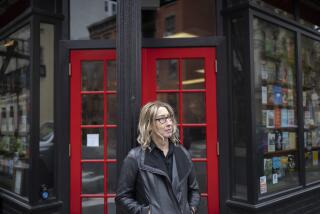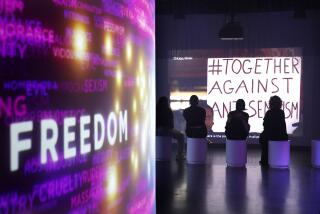A century ago, a popular Missouri newspaper demonized a religious minority: Catholics
- Share via
The year was 1915, and the strange new newspaper in Aurora, Mo., had grown so quickly in its first four years that rail officials had to build extra tracks for all the paper and printing materials suddenly rolling into town.
The Aurora post office, according to one account, more than tripled its staff to handle mail to and from the publication’s astonishing 1.5 million weekly subscribers — a circulation that dwarfed the largest daily newspapers in New York and Chicago.
Hatred had become big business in southwestern Missouri, and its name was the Menace, a weekly anti-Catholic newspaper whose headlines screamed to readers around the nation about predatory priests, women enslaved in convents and a dangerous Roman Catholic plot to take over America.
NEWSLETTER: Get the day’s top headlines from Times Editor Davan Maharaj >>
“The cowardice of a Roman thug has no parallel in either the human or animal kingdom,” the newspaper frothed in one 1914 edition, calling for “men with red blood in their veins” to defend women and children from Catholics. “If we are compelled to live in this county with Romanists, as our weak-kneed Protestant critics say we are, the Romanists will have to be taught their place in society.”
America’s deep and widespread skepticism of Catholics is a faint memory in today’s post-Sept. 11 world. But as some conservative politicians call for limits on Muslim immigration and raise questions about whether Muslims are more loyal to Islamic law than American law, the story of Aurora’s long-ago newspaper is a reminder of a long history of American religious intolerance.
Today, there are calls for federal surveillance of mosques in the name of preventing terrorist attacks; a century ago, it was state laws that allowed the warrantless search of convents and churches in search of supposedly trapped women and purported secret Catholic weapons caches.
“I see huge parallels,” said Sharon Davies, executive director of the Kirwan Institute for the Study of Race and Ethnicity at Ohio State University. “I think we haven’t seen anything quite like this since the beginning of the 20th century, when we passed laws that permitted the Catholics to be treated in ways that no other religious group was treated.”
Anti-Catholicism stretches back to the nation’s colonial times, when some states barred Catholics from holding office, and continued through the mid-1800s, which saw the Know-Nothing party’s campaign against Catholic politicians. Lynch mobs killed Italian immigrants and arsonists burned down Catholic churches.
Perhaps no publication captures the animus toward Catholicism at the start of the 20th century as vividly as the Menace, launched in an old opera house in Aurora in 1911, when the city’s population was only a little over 4,000.
The Menace wasn’t the country’s first anti-Catholic newspaper, but it quickly became one of the biggest, eventually selling anti-Catholic books and launching a lecture series. Its editor, the Rev. Theodore C. Walker, claimed its target was not rank-and-file Catholics but the Catholic Church itself.
“It begins a kind of tidal wave, a journalistic explosion that sweeps the entire country,” said Justin Nordstrom, an associate professor of history at Penn State Hazleton who has studied the Menace. “There are people paying attention to this newspaper — urban settings, rural settings — all across the country.”
On its banner, the Menace sometimes bore the logo of skull and crossbones wearing a papal hat, as well as a drawing of a public school, which is described as “the antidote for papal poison.”
“OPEN ROME’S PRISON HOUSES IN AMERICA!” blared one headline for a December 1911 story that claimed the church was murdering the babies of nuns and throwing the infant corpses into a pit.
In the same issue, the Menace urged its readers to vote against all Catholic political candidates regardless of party or platform, describing the church as “the most dangerous power that threatens our government today.” It added ominously, “A defeat at the polls today is far better than a defeat at arms tomorrow.”
“There was a widespread belief that Catholics were waiting for the day the pope would put into motion a campaign to make the country Catholic, and in the meantime amassing [stockpiles] of weaponry that would be used when that day came,” Davies said.
Not everyone bought what the Menace was selling — which was a year’s subscription for 50 cents.
“It is a menace to decency — a menace to peace and order — a menace to tolerance — a menace to true Americanism — a menace to the spirit of fraternity,” Chicago journalist Charles A. Windle wrote in one broadside against the weekly. “It breeds bitterness and strife between neighbors and converts life-long friends into enemies. Its columns reek with slander. Every page is a seething cesspool, in which writhe and wriggle hell-born lies.”
Catholic leaders also mobilized against the Menace, clipping out accounts asserting lewd behavior by priests to prompt federal prosecutors to indict the paper’s editors on suspicion of mailing obscene materials, according to Nordstrom’s book on the anti-Catholic press, “Danger on the Doorstep.”
When the Menace won the federal obscenity trial in Joplin, Mo., in 1916, one sympathizer wrote that Aurora celebrated, with “an immense crowd comprising more than half the population gathered at the depot, headed by the band, and when the defendants stepped from the train they were royally welcomed.” The Menace described its home base as “The World’s Headquarters for Anti-Papal Literature.”
“It was a black page in Aurora’s past,” said Mary Strickrodt, president of Aurora’s historical society. “I wish everyone had been aghast and run them out of town, but it seems to have hired a lot of people. We have postcards [showing] a huge amount of train cars being loaded with the newspaper to be shipped out.”
The paper’s immense popularity Strickrodt finds baffling.
“Why did it get big?” she wondered. “Why are people so quick to find people to hate? To be bigger than?”
The paper’s circulation declined as the nation turned its attention to the First World War, and soon after the newspaper’s printing plant burned down in 1919, the Menace sputtered out, along with other anti-Catholic publications.
Anti-Catholicism lived on in the Ku Klux Klan, but after the country elected its first Roman Catholic president, John F. Kennedy, in 1960, the worst of the hatred seemed to fade.
Rick Hinshaw, a spokesman for the Catholic League for Religious and Civil Rights, said the group’s biggest concerns today are anti-Catholic depictions on TV and in movies and the federal government’s healthcare mandates.
“Today, it’s more the cultural elite that we feel we run into,” Hinshaw said.
Little trace remains of the Menace in Aurora, except when new homeowners tear down walls or explore attics and find copies, like the man from Rhode Island who moved to town and called local Chamber of Commerce director Shannon Walker to tell her about a strange discovery in his home.
“You’ll never guess what I found,” Walker recalled the man telling her.
“The Menace?” she replied.
“How did you know?”
Twitter: @mattdpearce
ALSO
Media sharpen Trump coverage after candidate calls for Muslim ban
The buildings we live in and the threat they pose to global warming
German leader Angela Merkel named Time magazine’s Person of the Year
More to Read
Sign up for Essential California
The most important California stories and recommendations in your inbox every morning.
You may occasionally receive promotional content from the Los Angeles Times.











